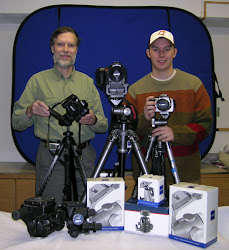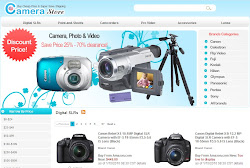This is the first in a series of profiles of photographers from various parts of the imaging spectrum. In the future we will shine the light on news photographers, commercial photographers, nature photographers and so on in order to give you the digital photographer some valuable insights to help make your images better.
Geraldine Allen is our first subject artist in the spot light. Initially trained in art history and graphic design in the UK; Geraldine gained valuable experience in aesthetics and design principles. Later in life she undertook study of Psychology and graduated with a Bachelor of Science Honors degree. However, Geraldine's long time interest and passion for photography drew her back. Enthused by the possibilities brought about by Adobe Photoshop in its early days of development, she was soon absorbed by experimenting with digitized photographic collages. It was then she decided to return to Salisbury College in the UK to formalize her experience and update her knowledge of the visual media industry.
Geraldine studied Creative Digital Arts to familiarize herself with industry standard multimedia software, and wishing to focus on still imaging, then chose to complete her BA (Honors) in PhotoMedia (Photography). Whilst computer manipulation was becoming increasingly popular, she chose to experiment [and now favors] "in camera" effects.
When did your "aha" moment arrive; the time when you knew that your affinity for photography could take you further regarding your creative and professional career? "I took a candid shot of my teenage son one day when I just happened to be at an elevated height; the combination of height, the long lens, and the way I had composed his posture in the frame brought an interesting result and I thought then that there are so many variables and I would never get bored if I did this for a living. I had always enjoyed photography but I didn't really learn much until digital came along. All of a sudden I learned so fast because the results were instant and I could relate which mistakes were associated with which controls."
Do you prefer total control over your photographic subjects or do you sometimes shoot natural non-studio images? "I don't have a preference. I am so passionate about photography and there are so many different aspects that I find it impossible to hold favoritism. I have to separate photography into genres and I take a different approach according to that genre. For example, creative photos are pre-conceived in the mind of the photographer/artist, so it does require the subject to be set up and controlled - to a degree. Although studio controlled images dominate my light painted portfolio, I often leave people as subjects to position themselves. The picture aims to portray a little essence of their natural character. I do help them with ideas if they are stuck though, usually by distracting them with conversation and saying "hold it there" when I think a particular posture, expression or mannerism would work well for the picture.
For nature pictures I rarely control anything except perhaps using a little fill flash or a reflector in conjunction with the available light. I make a conscious effort not to interfere with a natural scene as I wish to document it as real and naturally as possible. Having said that I must confess I can't help moving obtrusive litter, sticks or stones from the frame."
Have you ever had a mentor who had an impact on your style and art? "I received an awful lot of support from a wonderful tutor called Ian Smith at Salisbury College in the UK. Whilst I was given endless encouragement to experiment in whichever way I liked, I was also taught to question everything and to give that experimentation some decisive direction. I was to ask myself what my pictures were trying to communicate, and to plan them with specific intention and aims. In the final year at Salisbury College I reached the dreaded stage where I was forced to choose one field of specialization. God forbid, how was I to make a single choice when I loved all and sundry from traditional to completely abstract and contemporary? I remember actually struggling to hold back tears when it came to the point of my having to drop some genres. I was a cop-out really because I chose to stick with two fields instead of one; fine art and nature, and then I used a unifying concept to put them both in my final portfolio!
I was also privileged enough to work with landscape photographer Charlie Waite in his studio for some months. Although practicalities of work and business dominated our concerns, I observed his attitudes toward his projects and indeed within his natural day-to-day practicalities. If I had to choose one primary point that I will always remember, it would be how he would look at the sky and all around whenever he stepped outdoors. He would immediately and instinctively study the light and how it fell upon subjects in his immediate surroundings, no matter where he was or what he was doing. You could say he was obsessed with light! So, he taught me the most valuable lesson of all; to study the natural laws of light, how it naturally affected the world around and how different it looked according to the various conditions."
Your best advice for budding digital photographers? "Experiment, and then experiment some more! Make full use of manual controls instead of sticking with the safe Auto mode. Don't just refer to the manual when you are stuck on how to operate a basic control, but read it all from front to back and then test out each and every advanced control. That way you get to know your camera thoroughly, and you may happen upon some interesting effects. Try different levels of fill flash, use the white balance, and test the effects of speed/aperture on depth of field. Oh, and look at possible uses for any mistakes! I have been known to use prior unintentional mistakes, as deliberate controlled effects at a later date."
What kind of digital camera gear do you favor? "Predominantly, I am a digital SLR user of the Canon variety. I just like the look, the feel and the performance of Canon. A Canon feels right in my hand so what more can I say?
Currently I am shooting with a Canon D60, which I was very happy to own when they were first released. Unfortunately 6 months down the line the 10D was released with a substantial drop in price to boot. Now of course there is the 20D too! Such are the agonies of being a die-hard techie fiend. I use only fixed focal length lenses, having found the 'ever-practical' zoom to let me down with zoom creep on long exposures."
Currently Geraldine is using four lenses: a 15mm f/2.8 fisheye, a 35mm f/2, a 100m f/2.8 Macro, and a 200mm f/2.8 L - all Canon EF. Of course using these lenses on a DSLR mean the focal length is longer than using on a film SLR due to the size of the sensor, which is why the fisheye is not truly 'fisheye' but just very wide, and the 35mm is used as the standard workhorse lens - the equivalent of a 50mm. Shooting an awful lot of nature pictures, her 100mm macro lens has proved a wise investment, allowing her to gain that extra close distance both for macro work and longer distance shots.
Geraldine says "I have never had much desire to shoot very long distance. I tried a 300mm 'L' glass once, but sold it within a fortnight. The thing was a monster, and at f5.6 widest aperture, it was just not fast enough coupled with the focal length and weight of the thing. I simply could not achieve sharp enough pictures. Rather than bring faraway subjects close to me, I prefer bringing tiny things into my visual plane, so that I can study each tiny little detail. I therefore have a natural affinity for Macro photography and Photomicrography. I use an IMXZ Microscope with a zoom factor from x10 - x40 for real tiny subjects, or when I want to reveal what the eye cannot normally see, but with an aperture of f0, I am inevitably dissatisfied with the lack of sharpness throughout. Quite often I will just use the 'sweet spot' area and crop down afterward. I also have a bellows for an FD lens but I rarely achieve a satisfactory result owing to the lack of mobility and adaptability. I would really enjoy the more mobile MP-E65 but unfortunately it's not within the budget at the present time.
I missed the medium format experience altogether, but what a great discovery it was to find out I could afford a large format system! I ended up with a 4x5 Toyo View camera with a monorail extension, dark cloth, lots of double dark slides, an Schneider Symmar-S 150mm f5.6, and two boxes of Fuji Provia RDP II, all for £400!!! The film and processing costs have been adding up since, and the results still look plainly 'LF novice'. "
The only other shooting equipment I have are two strobes, a 1000 watt halogen lamp, a Canon Speedlite 550EX, softbox, reflectors and stands. These are not used very often, but are on standby for the odd studio request. Generally though I prefer natural light and natural settings.
Post shoot editing of course requires a digital darkroom. I use a fast processor Dell PC with tons of RAM, a Mac Powerbook G4, an Olympus Camedia Dye Sub printer, a Canon S9000 inkjet, and an Epson Perfection 4870 scanner for my 4x5 film. Let's also not forget that king of king piece of software - Adobe Photoshop. I just upgraded to CS and I'm not disappointed. ooops... I forgot to mention my trusty set of three halogen torches for light painting.... nothing special or expensive, just normal household torches of various strength." Says Ms Allen.
Geraldine has always been intrigued by the magical, unique and otherworldly qualities found in the work of photographers like Robert Damachy, Julia Margaret Cameron, Diane Arbus, and Sarah Moon. Specific influences on her photographic development with her light painting have been Berthold Steinhilber, Jorg Grundler, and Diana Thorneycroft.
If you visit her site you will see some of the wonderful macro photography Geraldine captures. Many of those are floral based subject matter. She says "for floral macros, I like to use extremely limited depth of field. This means I inevitably make use of a longer focal length [100mm], the closest shooting distance possible and a wide aperture [often f2]. This usually means the shutter speed is quite fast because there is plenty of light entering the lens. But, that does not mean I do not need a tripod in a natural setting. Often I like to have only the tiniest element in focus, which means handheld shooting is a definite no-no, as the plane of focus can slip at the slightest movement [in the camera or subject]. If the element to be focused on is flat, then generally it is easier to achieve sharpness where I want it. However if it is curved or rounded I try to make sure the camera is positioned at such an angle as to allow the element to be parallel with the back of the camera so that as much of the element as possible is on the same plane as the sensor or film back."
You can see the portfolio of her fine art photography at her web site: www.photo-art-gallery.com
Thanks To : Cheap Clothing Optional Galleries Store

























